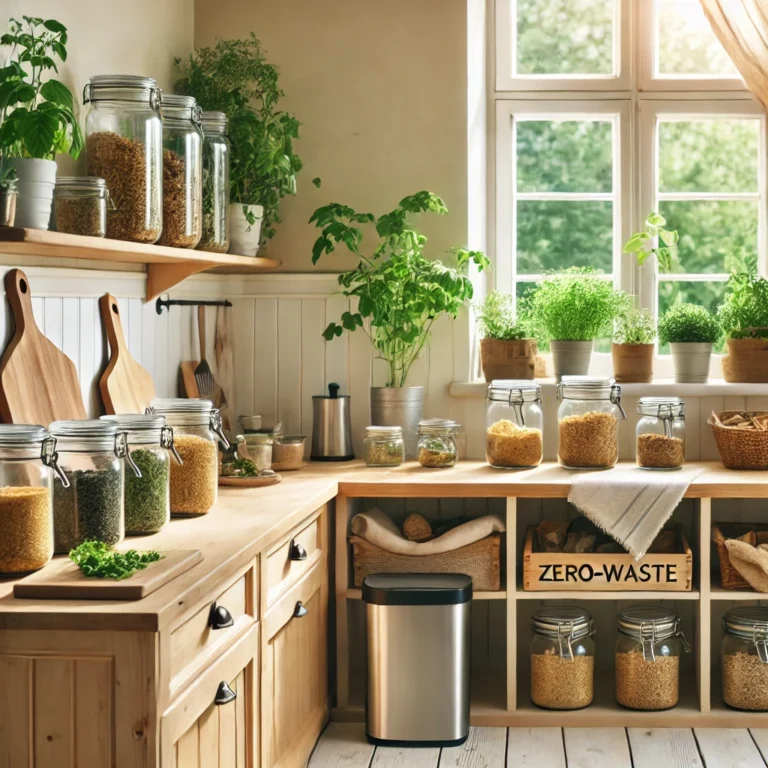Physical Address
304 North Cardinal St.
Dorchester Center, MA 02124
Physical Address
304 North Cardinal St.
Dorchester Center, MA 02124


The kitchen is often the heart of the home—but it can also be a source of significant waste. From food scraps to single-use packaging, the kitchen contributes to a large portion of household waste. However, making your kitchen more eco-friendly doesn’t have to be overwhelming. A zero-waste kitchen is about minimizing waste, making sustainable choices, and reducing your environmental footprint in ways that work for your lifestyle.
In this blog, we’ll explore practical tips and easy steps to help you start a zero-waste kitchen, no matter where in the world you live. By following these suggestions, you can create a kitchen that’s more efficient, eco-friendly, and ultimately better for the planet.
Reducing waste in the kitchen helps combat some of the biggest environmental challenges we face today, including plastic pollution, food waste, and over-consumption of natural resources. Food waste alone accounts for roughly one-third of all food produced globally, while plastic packaging fills landfills and pollutes oceans.
Transitioning to a zero-waste kitchen isn’t just about minimizing what ends up in the trash—it’s about rethinking the way we consume and using resources more responsibly.
A key principle of a zero-waste kitchen is avoiding packaging, especially single-use plastics. One way to do this is by buying food in bulk. Many grocery stores and health food stores now offer bulk sections where you can fill your own reusable containers with items like grains, nuts, beans, and spices.
Tip: Bring your own reusable produce bags and containers when shopping. This not only cuts down on waste but can also help you save money by buying only what you need.
Learn more about plastic pollution and why it matters.
No matter how efficient you are in the kitchen, food scraps are inevitable. Instead of throwing them away, start a compost bin for food waste like fruit and vegetable peels, coffee grounds, and eggshells. Composting reduces landfill waste and produces nutrient-rich soil that you can use for gardening or donate to local farms.
If composting at home isn’t an option due to space or local regulations, many cities now offer compost drop-off programs or curbside compost collection.
In urban centers like San Francisco, composting has become a citywide initiative, with residents diverting over 80% of their waste from landfills. Composting food scraps has proven to be one of the most effective methods of reducing household waste, even in densely populated areas.
A zero-waste kitchen relies on reusables rather than disposables. This applies to everything from storage containers to utensils. Swap out plastic wrap for beeswax wraps, paper towels for reusable cloths, and plastic food storage for glass or stainless steel containers.
Tip: Keep a set of reusable containers and bags by the door or in your car, so they’re always handy when you head to the store.
Food waste is a major contributor to kitchen waste. Storing food properly can help extend its shelf life and reduce the amount you throw away. Keep perishable foods like fruits and vegetables in the fridge, use airtight containers for dry goods, and label leftovers with the date to ensure you use them before they spoil.
Tip: If you have extra fruits or veggies that might go bad, consider freezing them or turning them into sauces, soups, or jams to enjoy later.
Planning your meals is an effective way to reduce kitchen waste. By planning out what you’ll cook for the week, you can buy only what you need and avoid impulse purchases that lead to food waste. Not only will this help reduce waste, but it will also save you time and money.
Check out this report on global food waste and see how meal planning can make a difference.
Growing your own herbs, vegetables, and even fruits can be a fun and rewarding way to cut down on waste. Whether you have a large garden or a small windowsill, growing your own produce reduces the need for packaging and transportation. Plus, it’s a great way to ensure you’re eating organic, pesticide-free food.
Tip: Start with easy-to-grow herbs like basil, mint, and rosemary, which can thrive indoors and don’t require much space.
Many commercial kitchen cleaners come in single-use plastic bottles and contain harmful chemicals. Making your own cleaning products using simple, non-toxic ingredients like vinegar, baking soda, and essential oils is a great way to reduce plastic waste and keep your kitchen eco-friendly.
Energy efficiency is an important part of a zero-waste kitchen. Older appliances tend to use more energy, so when it’s time to upgrade, choose energy-efficient models. Look for the Energy Star label when purchasing new appliances, such as refrigerators, ovens, and dishwashers, to reduce both your energy consumption and your overall environmental impact.
Find energy-efficient appliances here.
Starting a zero-waste kitchen doesn’t happen overnight, but by making small changes—like composting food scraps, buying in bulk, and switching to reusables—you can significantly reduce your kitchen waste and contribute to a more sustainable lifestyle. Whether you’re new to the zero-waste movement or a seasoned pro, every step you take towards a waste-free kitchen makes a big impact.
Now that you have the tools to get started, why not begin today? Embrace the zero-waste lifestyle, and together, we can help create a greener planet—one kitchen at a time.
Discover more zero-waste living tips and continue your journey toward a sustainable lifestyle!